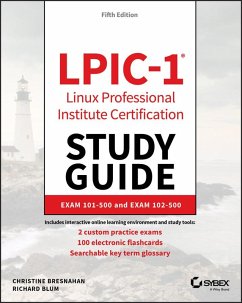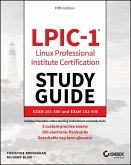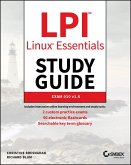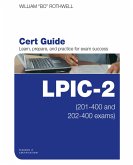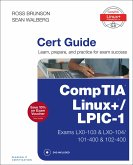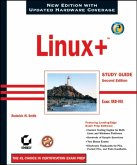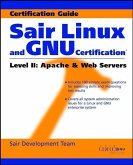LPIC-1 Linux Professional Institute Certification Study Guide (eBook, PDF)
Exam 101-500 and Exam 102-500


Alle Infos zum eBook verschenken

LPIC-1 Linux Professional Institute Certification Study Guide (eBook, PDF)
Exam 101-500 and Exam 102-500
- Format: PDF
- Merkliste
- Auf die Merkliste
- Bewerten Bewerten
- Teilen
- Produkt teilen
- Produkterinnerung
- Produkterinnerung

Hier können Sie sich einloggen

Bitte loggen Sie sich zunächst in Ihr Kundenkonto ein oder registrieren Sie sich bei bücher.de, um das eBook-Abo tolino select nutzen zu können.
The bestselling study guide for the popular Linux Professional Institute Certification Level 1 (LPIC-1). The updated fifth edition of LPIC-1: Linux Professional Institute Certification Study Guide is a comprehensive, one-volume resource that covers 100% of all exam objectives. Building on the proven Sybex Study Guide approach, this essential resource offers a comprehensive suite of study and learning tools such as assessment tests, hands-on exercises, chapter review questions, and practical, real-world examples. This book, completely updated to reflect the latest 101-500 and 102-500 exams,…mehr
- Geräte: PC
- mit Kopierschutz
- eBook Hilfe
- Größe: 13.49MB
![LPIC-1 Linux Professional Institute Certification Study Guide (eBook, ePUB) LPIC-1 Linux Professional Institute Certification Study Guide (eBook, ePUB)]() Christine BresnahanLPIC-1 Linux Professional Institute Certification Study Guide (eBook, ePUB)40,99 €
Christine BresnahanLPIC-1 Linux Professional Institute Certification Study Guide (eBook, ePUB)40,99 €![LPIC-2 (eBook, PDF) LPIC-2 (eBook, PDF)]() Christine BresnahanLPIC-2 (eBook, PDF)47,99 €
Christine BresnahanLPIC-2 (eBook, PDF)47,99 €![LPI Linux Essentials Study Guide (eBook, PDF) LPI Linux Essentials Study Guide (eBook, PDF)]() Christine BresnahanLPI Linux Essentials Study Guide (eBook, PDF)32,99 €
Christine BresnahanLPI Linux Essentials Study Guide (eBook, PDF)32,99 €![LPIC-2 Cert Guide (eBook, PDF) LPIC-2 Cert Guide (eBook, PDF)]() William RothwellLPIC-2 Cert Guide (eBook, PDF)28,95 €
William RothwellLPIC-2 Cert Guide (eBook, PDF)28,95 €![CompTIA Linux+ / LPIC-1 Pearson uCertify Course Student Access Card (eBook, PDF) CompTIA Linux+ / LPIC-1 Pearson uCertify Course Student Access Card (eBook, PDF)]() Ross BrunsonCompTIA Linux+ / LPIC-1 Pearson uCertify Course Student Access Card (eBook, PDF)20,95 €
Ross BrunsonCompTIA Linux+ / LPIC-1 Pearson uCertify Course Student Access Card (eBook, PDF)20,95 €![Linux+ Study Guide (eBook, PDF) Linux+ Study Guide (eBook, PDF)]() Roderick W. SmithLinux+ Study Guide (eBook, PDF)45,50 €
Roderick W. SmithLinux+ Study Guide (eBook, PDF)45,50 €![Sair Linux and GNU Certification Level II, Apache and Web Servers (eBook, PDF) Sair Linux and GNU Certification Level II, Apache and Web Servers (eBook, PDF)]() Sair Development TeamSair Linux and GNU Certification Level II, Apache and Web Servers (eBook, PDF)36,40 €
Sair Development TeamSair Linux and GNU Certification Level II, Apache and Web Servers (eBook, PDF)36,40 €-
-
-
Dieser Download kann aus rechtlichen Gründen nur mit Rechnungsadresse in A, B, BG, CY, CZ, D, DK, EW, E, FIN, F, GR, HR, H, IRL, I, LT, L, LR, M, NL, PL, P, R, S, SLO, SK ausgeliefert werden.
- Produktdetails
- Verlag: Wiley-ISTE
- Seitenzahl: 688
- Erscheinungstermin: 3. Oktober 2019
- Englisch
- ISBN-13: 9781119582090
- Artikelnr.: 58045175
- Verlag: Wiley-ISTE
- Seitenzahl: 688
- Erscheinungstermin: 3. Oktober 2019
- Englisch
- ISBN-13: 9781119582090
- Artikelnr.: 58045175
- Herstellerkennzeichnung Die Herstellerinformationen sind derzeit nicht verfügbar.
Assessment Test xxxix
Part I Exam 101-500 1
Chapter 1 Exploring Linux Command-Line Tools 3
Understanding Command-Line Basics 4
Discussing Distributions 4
Reaching a Shell 5
Exploring Your Linux Shell Options 5
Using a Shell 7
Using Environment Variables 11
Getting Help 17
Editing Text Files 20
Looking at Text Editors 20
Understanding vim Modes 24
Exploring Basic Text-Editing Procedures 24
Saving Changes 27
Processing Text Using Filters 28
File-Combining Commands 28
File-Transforming Commands 31
File-Formatting Commands 33
File-Viewing Commands 36
File-Summarizing Commands 40
Using Regular Expressions 45
Using grep 45
Understanding Basic Regular Expressions 47
Understanding Extended Regular Expressions 50
Using Streams, Redirection, and Pipes 50
Redirecting Input and Output 51
Piping Data between Programs 55
Using sed 56
Generating Command Lines 60
Summary 61
Exam Essentials 61
Review Questions 62
Chapter 2 Managing Software and Processes 67
Looking at Package Concepts 68
Using RPM 69
RPM Distributions and Conventions 69
The rpm Command Set 71
Extracting Data from RPMs 77
Using YUM 78
Using ZYpp 83
Using Debian Packages 86
Debian Package File Conventions 87
The dpkg Command Set 87
Looking at the APT Suite 92
Using apt-cache 93
Using apt-get 94
Reconfiguring Packages 97
Managing Shared Libraries 98
Library Principles 98
Locating Library Files 99
Loading Dynamically 100
Library Management Commands 100
Managing Processes 102
Examining Process Lists 102
Employing Multiple Screens 109
Understanding Foreground and Background Processes 116
Managing Process Priorities 120
Sending Signals to Processes 121
Summary 126
Exam Essentials 127
Review Questions 129
Chapter 3 Configuring Hardware 133
Configuring the Firmware and Core Hardware 134
Understanding the Role of Firmware 134
Device Interfaces 136
The /dev Directory 138
The /proc Directory 139
The /sys Directory 143
Working with Devices 144
Hardware Modules 148
Storage Basics 154
Types of Drives 154
Drive Partitions 155
Automatic Drive Detection 155
Storage Alternatives 156
Multipath 156
Logical Volume Manager 157
Using RAID Technology 158
Partitioning Tools 158
Working with fdisk 158
Working with gdisk 161
The GNU parted Command 162
Graphical Tools 163
Understanding Filesystems 164
The Virtual Directory 164
Maneuvering Around the Filesystem 166
Formatting Filesystems 167
Common Filesystem Types 167
Creating Filesystems 169
Mounting Filesystems 170
Manually Mounting Devices 170
Automatically Mounting Devices 172
Managing Filesystems 173
Retrieving Filesystem Stats 173
Filesystem Tools 173
Summary 174
Exam Essentials 175
Review Questions 177
Chapter 4 Managing Files 181
Using File Management Commands 182
Naming and Listing Files 182
Exploring Wildcard Expansion Rules 186
Understanding the File Commands 189
Compressing File Commands 199
Archiving File Commands 202
Managing Links 213
Managing File Ownership 218
Assessing File Ownership 219
Changing a File's Owner 219
Changing a File's Group 220
Controlling Access to Files 221
Understanding Permissions 221
Changing a File's Mode 223
Setting the Default Mode 226
Changing Special Access Modes 228
Locating Files 229
Getting to Know the FHS 229
Employing Tools to Locate Files 231
Summary 239
Exam Essentials 239
Review Questions 241
Chapter 5 Booting, Initializing, and Virtualizing Linux 245
Understanding the Boot Process 246
The Boot Process 246
Extracting Information about the Boot Process 247
Looking at Firmware 249
The BIOS Startup 249
The UEFI Startup 250
Looking at Boot Loaders 251
Boot Loader Principles 251
Using GRUB Legacy as the Boot Loader 251
Using GRUB 2 as the Boot Loader 255
Adding Kernel Boot Parameters 259
Using Alternative Boot Loaders 260
The Initialization Process 261
Using the systemd Initialization Process 262
Exploring Unit Files 263
Focusing on Service Unit Files 265
Focusing on Target Unit Files 268
Looking at systemctl 270
Examining Special systemd Commands 273
Using the SysV Initialization Process 276
Understanding Runlevels 277
Investigating SysVinit Commands 280
Stopping the System 283
Notifying the Users 284
Virtualizing Linux 286
Looking at Virtual Machines 287
Understanding Containers 291
Looking at Infrastructure as a Service 293
Summary 295
Exam Essentials 295
Review Questions 298
Part II Exam 102-500 303
Chapter 6 Configuring the GUI, Localization, and Printing 305
Understanding the GUI 306
Understanding the X11 Architecture 307
Examining X.Org 308
Figuring Out Wayland 309
Managing the GUI 311
Standard GUI Features 311
The X GUI Login System 313
Common Linux Desktop Environments 314
Providing Accessibility 323
Using X11 for Remote Access 325
Remote X11 Connections 326
Tunneling your X11 Connection 326
Using Remote Desktop Software 328
Viewing VNC 328
Grasping Xrdp 330
Exploring NX 332
Studying SPICE 332
Understanding Localization 333
Character Sets 333
Environment Variables 334
Setting Your Locale 335
Installation Locale Decisions 335
Changing Your Locale 336
Looking at Time 338
Working with Time Zones 338
Setting the Time and Date 339
Configuring Printing 343
Summary 345
Exam Essentials 346
Review Questions 348
Chapter 7 Administering the System 353
Managing Users and Groups 354
Understanding Users and Groups 354
Configuring User Accounts 355
Configuring Groups 371
Managing Email 375
Understanding Email 375
Choosing Email Software 376
Working with Email 377
Using Log and Journal Files 384
Examining the syslog Protocol 385
Viewing the History of Linux Logging 387
Logging Basics Using rsyslogd 387
Journaling with systemd-journaldd 394
Maintaining the System Time 403
Understanding Linux Time Concepts 403
Viewing and Setting Time 404
Understanding the Network Time Protocol 408
Using the NTP Daemon 411
Using the chrony Daemon 413
Summary 416
Exam Essentials 416
Review Questions 419
Chapter 8 Configuring Basic Networking 423
Networking Basics 424
The Physical Layer 424
The Network Layer 426
The Transport Layer 430
The Application Layer 431
Configuring Network Features 433
Network Configuration Files 433
Graphical Tools 436
Command-Line Tools 438
Getting Network Settings Automatically 445
Bonding Network Cards 445
Basic Network Troubleshooting 447
Sending Test Packets 447
Tracing Routes 448
Finding Host Information 449
Advanced Network Troubleshooting 452
The netstat Command 452
Examining Sockets 455
The netcat Utility 456
Summary 457
Exam Essentials 458
Review Questions 460
Chapter 9 Writing Scripts 465
Shell Variables 466
Global Environment Variables 466
Local Environment Variables 468
Setting Local Environment Variables 470
Setting Global Environment Variables 472
Locating System Environment Variables 472
Using Command Aliases 474
The Basics of Shell Scripting 475
Running Multiple Commands 475
Redirecting Output 476
Piping Data 477
The Shell Script Format 478
Running the Shell Script 479
Advanced Shell Scripting 481
Displaying Messages 481
Using Variables in Scripts 482
Command-Line Arguments 484
Getting User Input 484
The Exit Status 488
Writing Script Programs 489
Command Substitution 489
Performing Math 490
Logic Statements 492
Loops 496
Functions 498
Running Scripts in Background Mode 500
Running in the Background 501
Running Multiple Background Jobs 502
Running Scripts Without a Console 503
Sending Signals 504
Interrupting a Process 504
Pausing a Process 504
Job Control 506
Viewing Jobs 506
Restarting Stopped Jobs 508
Running Like Clockwork 509
Scheduling a Job Using the at Command 509
Scheduling Regular Scripts 513
Summary 515
Exam Essentials 516
Review Questions 518
Chapter 10 Securing Your System 523
Administering Network Security 524
Disabling Unused Services 524
Using Super Server Restrictions 534
Restricting via TCP Wrappers 538
Administering Local Security 539
Securing Passwords 539
Limiting root Access 543
Auditing User Access 547
Setting Login, Process, and Memory Limits 549
Locating SUID/SGID Files 551
Exploring Cryptography Concepts 553
Discovering Key Concepts 553
Securing Data 554
Signing Transmissions 555
Looking at SSH 555
Exploring Basic SSH Concepts 555
Configuring SSH 558
Generating SSH Keys 560
Authenticating with SSH Keys 561
Authenticating with the Authentication Agent 564
Tunneling 565
Using SSH Securely 567
Using GPG 567
Generating Keys 568
Importing Keys 569
Encrypting and Decrypting Data 570
Signing Messages and Verifying Signatures 571
Revoking a Key 573
Summary 574
Exam Essentials 575
Review Questions 577
Appendix Answers to Review Questions 583
Chapter 1: Exploring Linux Command-Line Tools 584
Chapter 2: Managing Software and Processes 587
Chapter 3: Configuring Hardware 590
Chapter 4: Managing Files 593
Chapter 5: Booting, Initializing, and Virtualizing Linux 597
Chapter 6: Configuring the GUI, Localization, and Printing 601
Chapter 7: Administering the System 605
Chapter 8: Configuring Basic Networking 608
Chapter 9: Writing Scripts 611
Chapter 10: Securing Your System 615
Index 619
Assessment Test xxxix
Part I Exam 101-500 1
Chapter 1 Exploring Linux Command-Line Tools 3
Understanding Command-Line Basics 4
Discussing Distributions 4
Reaching a Shell 5
Exploring Your Linux Shell Options 5
Using a Shell 7
Using Environment Variables 11
Getting Help 17
Editing Text Files 20
Looking at Text Editors 20
Understanding vim Modes 24
Exploring Basic Text-Editing Procedures 24
Saving Changes 27
Processing Text Using Filters 28
File-Combining Commands 28
File-Transforming Commands 31
File-Formatting Commands 33
File-Viewing Commands 36
File-Summarizing Commands 40
Using Regular Expressions 45
Using grep 45
Understanding Basic Regular Expressions 47
Understanding Extended Regular Expressions 50
Using Streams, Redirection, and Pipes 50
Redirecting Input and Output 51
Piping Data between Programs 55
Using sed 56
Generating Command Lines 60
Summary 61
Exam Essentials 61
Review Questions 62
Chapter 2 Managing Software and Processes 67
Looking at Package Concepts 68
Using RPM 69
RPM Distributions and Conventions 69
The rpm Command Set 71
Extracting Data from RPMs 77
Using YUM 78
Using ZYpp 83
Using Debian Packages 86
Debian Package File Conventions 87
The dpkg Command Set 87
Looking at the APT Suite 92
Using apt-cache 93
Using apt-get 94
Reconfiguring Packages 97
Managing Shared Libraries 98
Library Principles 98
Locating Library Files 99
Loading Dynamically 100
Library Management Commands 100
Managing Processes 102
Examining Process Lists 102
Employing Multiple Screens 109
Understanding Foreground and Background Processes 116
Managing Process Priorities 120
Sending Signals to Processes 121
Summary 126
Exam Essentials 127
Review Questions 129
Chapter 3 Configuring Hardware 133
Configuring the Firmware and Core Hardware 134
Understanding the Role of Firmware 134
Device Interfaces 136
The /dev Directory 138
The /proc Directory 139
The /sys Directory 143
Working with Devices 144
Hardware Modules 148
Storage Basics 154
Types of Drives 154
Drive Partitions 155
Automatic Drive Detection 155
Storage Alternatives 156
Multipath 156
Logical Volume Manager 157
Using RAID Technology 158
Partitioning Tools 158
Working with fdisk 158
Working with gdisk 161
The GNU parted Command 162
Graphical Tools 163
Understanding Filesystems 164
The Virtual Directory 164
Maneuvering Around the Filesystem 166
Formatting Filesystems 167
Common Filesystem Types 167
Creating Filesystems 169
Mounting Filesystems 170
Manually Mounting Devices 170
Automatically Mounting Devices 172
Managing Filesystems 173
Retrieving Filesystem Stats 173
Filesystem Tools 173
Summary 174
Exam Essentials 175
Review Questions 177
Chapter 4 Managing Files 181
Using File Management Commands 182
Naming and Listing Files 182
Exploring Wildcard Expansion Rules 186
Understanding the File Commands 189
Compressing File Commands 199
Archiving File Commands 202
Managing Links 213
Managing File Ownership 218
Assessing File Ownership 219
Changing a File's Owner 219
Changing a File's Group 220
Controlling Access to Files 221
Understanding Permissions 221
Changing a File's Mode 223
Setting the Default Mode 226
Changing Special Access Modes 228
Locating Files 229
Getting to Know the FHS 229
Employing Tools to Locate Files 231
Summary 239
Exam Essentials 239
Review Questions 241
Chapter 5 Booting, Initializing, and Virtualizing Linux 245
Understanding the Boot Process 246
The Boot Process 246
Extracting Information about the Boot Process 247
Looking at Firmware 249
The BIOS Startup 249
The UEFI Startup 250
Looking at Boot Loaders 251
Boot Loader Principles 251
Using GRUB Legacy as the Boot Loader 251
Using GRUB 2 as the Boot Loader 255
Adding Kernel Boot Parameters 259
Using Alternative Boot Loaders 260
The Initialization Process 261
Using the systemd Initialization Process 262
Exploring Unit Files 263
Focusing on Service Unit Files 265
Focusing on Target Unit Files 268
Looking at systemctl 270
Examining Special systemd Commands 273
Using the SysV Initialization Process 276
Understanding Runlevels 277
Investigating SysVinit Commands 280
Stopping the System 283
Notifying the Users 284
Virtualizing Linux 286
Looking at Virtual Machines 287
Understanding Containers 291
Looking at Infrastructure as a Service 293
Summary 295
Exam Essentials 295
Review Questions 298
Part II Exam 102-500 303
Chapter 6 Configuring the GUI, Localization, and Printing 305
Understanding the GUI 306
Understanding the X11 Architecture 307
Examining X.Org 308
Figuring Out Wayland 309
Managing the GUI 311
Standard GUI Features 311
The X GUI Login System 313
Common Linux Desktop Environments 314
Providing Accessibility 323
Using X11 for Remote Access 325
Remote X11 Connections 326
Tunneling your X11 Connection 326
Using Remote Desktop Software 328
Viewing VNC 328
Grasping Xrdp 330
Exploring NX 332
Studying SPICE 332
Understanding Localization 333
Character Sets 333
Environment Variables 334
Setting Your Locale 335
Installation Locale Decisions 335
Changing Your Locale 336
Looking at Time 338
Working with Time Zones 338
Setting the Time and Date 339
Configuring Printing 343
Summary 345
Exam Essentials 346
Review Questions 348
Chapter 7 Administering the System 353
Managing Users and Groups 354
Understanding Users and Groups 354
Configuring User Accounts 355
Configuring Groups 371
Managing Email 375
Understanding Email 375
Choosing Email Software 376
Working with Email 377
Using Log and Journal Files 384
Examining the syslog Protocol 385
Viewing the History of Linux Logging 387
Logging Basics Using rsyslogd 387
Journaling with systemd-journaldd 394
Maintaining the System Time 403
Understanding Linux Time Concepts 403
Viewing and Setting Time 404
Understanding the Network Time Protocol 408
Using the NTP Daemon 411
Using the chrony Daemon 413
Summary 416
Exam Essentials 416
Review Questions 419
Chapter 8 Configuring Basic Networking 423
Networking Basics 424
The Physical Layer 424
The Network Layer 426
The Transport Layer 430
The Application Layer 431
Configuring Network Features 433
Network Configuration Files 433
Graphical Tools 436
Command-Line Tools 438
Getting Network Settings Automatically 445
Bonding Network Cards 445
Basic Network Troubleshooting 447
Sending Test Packets 447
Tracing Routes 448
Finding Host Information 449
Advanced Network Troubleshooting 452
The netstat Command 452
Examining Sockets 455
The netcat Utility 456
Summary 457
Exam Essentials 458
Review Questions 460
Chapter 9 Writing Scripts 465
Shell Variables 466
Global Environment Variables 466
Local Environment Variables 468
Setting Local Environment Variables 470
Setting Global Environment Variables 472
Locating System Environment Variables 472
Using Command Aliases 474
The Basics of Shell Scripting 475
Running Multiple Commands 475
Redirecting Output 476
Piping Data 477
The Shell Script Format 478
Running the Shell Script 479
Advanced Shell Scripting 481
Displaying Messages 481
Using Variables in Scripts 482
Command-Line Arguments 484
Getting User Input 484
The Exit Status 488
Writing Script Programs 489
Command Substitution 489
Performing Math 490
Logic Statements 492
Loops 496
Functions 498
Running Scripts in Background Mode 500
Running in the Background 501
Running Multiple Background Jobs 502
Running Scripts Without a Console 503
Sending Signals 504
Interrupting a Process 504
Pausing a Process 504
Job Control 506
Viewing Jobs 506
Restarting Stopped Jobs 508
Running Like Clockwork 509
Scheduling a Job Using the at Command 509
Scheduling Regular Scripts 513
Summary 515
Exam Essentials 516
Review Questions 518
Chapter 10 Securing Your System 523
Administering Network Security 524
Disabling Unused Services 524
Using Super Server Restrictions 534
Restricting via TCP Wrappers 538
Administering Local Security 539
Securing Passwords 539
Limiting root Access 543
Auditing User Access 547
Setting Login, Process, and Memory Limits 549
Locating SUID/SGID Files 551
Exploring Cryptography Concepts 553
Discovering Key Concepts 553
Securing Data 554
Signing Transmissions 555
Looking at SSH 555
Exploring Basic SSH Concepts 555
Configuring SSH 558
Generating SSH Keys 560
Authenticating with SSH Keys 561
Authenticating with the Authentication Agent 564
Tunneling 565
Using SSH Securely 567
Using GPG 567
Generating Keys 568
Importing Keys 569
Encrypting and Decrypting Data 570
Signing Messages and Verifying Signatures 571
Revoking a Key 573
Summary 574
Exam Essentials 575
Review Questions 577
Appendix Answers to Review Questions 583
Chapter 1: Exploring Linux Command-Line Tools 584
Chapter 2: Managing Software and Processes 587
Chapter 3: Configuring Hardware 590
Chapter 4: Managing Files 593
Chapter 5: Booting, Initializing, and Virtualizing Linux 597
Chapter 6: Configuring the GUI, Localization, and Printing 601
Chapter 7: Administering the System 605
Chapter 8: Configuring Basic Networking 608
Chapter 9: Writing Scripts 611
Chapter 10: Securing Your System 615
Index 619
